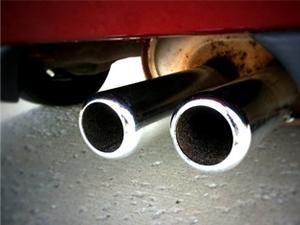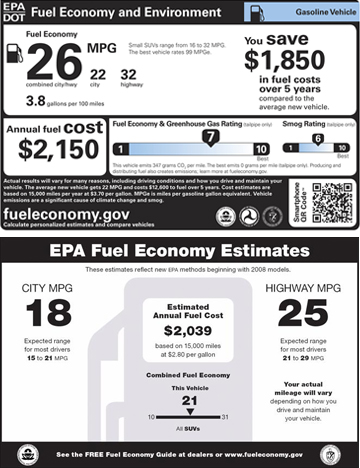 |
| Reviews and Templates for Expression We |
Revamped Vehicle Fuel Economy Stickers Add GHG, Savings Data

As part of what the U.S. Department of Transportation and Environmental Protection Agency are calling the "most dramatic overhaul" of fuel economy stickers, separate labels will be made for gasoline, hybrid electric and all-electric vehicles.
The new labels will include:
- City, highway and combines fuel economy, in miles per gallon
- Fuel economy range of similar vehicles
- How many gallons, or how much electricity, it takes to drive 100 miles
- Charge time for electric vehicles
- How far electric vehicles can travel on a single charge
- Annual fuel cost
- Estimated fuel savings over five years, compared to average new vehicles
- Fuel economy and greenhouse gas rating
- Smog rating

While costs and savings are likely a main consideration for people buying new vehicles, the new labels will also make it is easier for buyers to compare trade-offs like driving range and charging time among gasoline, hybrid and electric vehicles.
The new labels are a follow-up to the new fuel economy standards finalized by the Obama administration in 2010 that call for an average of 35.5 miles per gallon in model year 2012-2016 cars and trucks. The administration expects to put out fuel economy and GHG emission standards for 2017-2025 vehicles in September, and will announce the first standards for 2014-2018 commercial trucks, vans and buses in July.
Also this week, California-focused research organization Next 10 put out a report that says higher fuel economy standards will increase economic efficiency, create jobs and provide extra savings to businesses and consumers in the state.
Next 10 says that if fuel economy in California improves 4-6 percent from 2017-2025, the state could see an additional 38,000-236,000 jobs created, 8-19 percent reduction in GHG emissions, and a .82-1.31 percent gross state product increase.
Our libertarian Earth Hour-bashing friends over at the Competitive Enterprise Institute, meanwhile, were quick to rip on the new fuel economy labels. In a blog post about the news, Marlo Lewis pointed out that an initial plan to include letter grades on the labels was squashed, and rolled out the idea of the "MPG Illusion" — that people think all fuel economy increases have the same impact, when in fact raising vehicle fuel economy is of most benefit when it's applied in slight increments to highly inefficient vehicles.
Lewis elaborates:
...some may conclude, if they can’t afford (or simply don’t want) a Toyota Prius, Chevy Volt, or some other high-mpg vehicle, there’s no point in buying a car with only modestly better fuel economy than their current vehicle.
To the CEI, the government sees the MPG Illusion as the reason why people aren't switching to slightly more efficient vehicles, and the CEI feels that the inclusion of how much gas it takes to drive 100 miles is an attempt to push consumers away from SUVs.
Greenies would love to believe that the market for SUVs is sustained by an “illusion.” Because if that is so, then EPA and NHTSA can depress SUV sales just by making simple changes in how fuel-economy information is presented — just by redesigning the sticker!
The CEI doesn't present an alternative, and it's hard to take seriously arguments that it's a bad thing to give consumers more information to work with, in a standard fashion, when buying vehicles.
Published May 26, 2011
|
|
|
|
Copyright 2011 Energy and Technical Services Ltd. All Rights Reserved. Energyts.com |